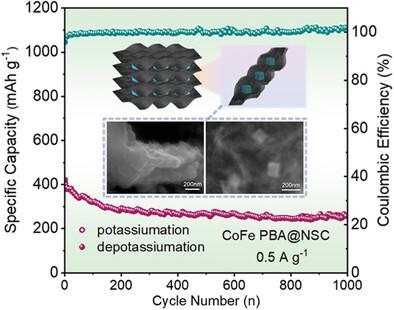Our official English website, www.x-mol.net, welcomes your feedback! (Note: you will need to create a separate account there.)
Thermal Induced Conversion of CoFe Prussian Blue Analogs Nanocubes Wrapped by Doped Carbon Network Exhibiting Fast and Stable Potassium Ion Storage as Anode
Small ( IF 13.0 ) Pub Date : 2023-12-24 , DOI: 10.1002/smll.202308484 Yujia Ouyang 1 , Ping Li 1 , Yu Ma 1 , Jiawei Wei 1 , Weiqian Tian 1 , Jingwei Chen 1 , Jing Shi 1 , Yue Zhu 1 , Jingyi Wu 1 , Huanlei Wang 1
Small ( IF 13.0 ) Pub Date : 2023-12-24 , DOI: 10.1002/smll.202308484 Yujia Ouyang 1 , Ping Li 1 , Yu Ma 1 , Jiawei Wei 1 , Weiqian Tian 1 , Jingwei Chen 1 , Jing Shi 1 , Yue Zhu 1 , Jingyi Wu 1 , Huanlei Wang 1
Affiliation

|
Prussian blue analogs (PBAs) show great promise as anode materials for potassium-ion batteries (PIBs) due to their high specific capacity. However, PBAs still suffer from the drawbacks of low electronic conductivity and poor structural stability, leading to inadequate rate and cyclic performance. To address these limitations, CoFe PBA nanocubes wrapped with N/S doped carbon network (CoFe PBA@NSC) as anode for PIBs is designed by using thermal-induced in situ conversion strategy. As expected, the structural advantages of nanosized PBA cubes, such as abundant interfaces and large surface area, enable the CoFe PBA@NSC electrode to demonstrate superior rate properties (557 and 131 mAh g−1 at 0.05 and 10 A g−1) and low capacity degradation (0.093% per cycle over 1000 cycles at 0.5 A g−1). Furthermore, several ex situ characterizations revealed the K-ion storage mechanism. Fe+ and Co0 are generated during potassicization, followed by a completely reversible chemical state of iron while some cobalt monomers remained during depotassication. Additionally, the as-built potassium-ion hybrid capacitor based on CoFe PBA@NSC anode exhibits a high energy density of 118 Wh kg−1. This work presents an alternative but promising synthesis route for Prussian blue analogs, which is significant for the advancement of PIBs and other related energy storage devices.
中文翻译:

掺杂碳网络包裹的 CoFe 普鲁士蓝类似物纳米立方体的热诱导转化,表现出快速稳定的钾离子存储作为阳极
普鲁士蓝类似物(PBA)由于其高比容量而显示出作为钾离子电池(PIB)阳极材料的巨大前景。然而,PBA仍然存在电子电导率低和结构稳定性差的缺点,导致倍率和循环性能不足。为了解决这些限制,采用热诱导原位转换策略设计了包裹有N/S掺杂碳网络的CoFe PBA纳米立方体(CoFe PBA@NSC)作为PIB的阳极。正如预期的那样,纳米级PBA立方体的结构优势,例如丰富的界面和大表面积,使CoFe PBA@NSC电极表现出优异的倍率性能(0.05和10 A g -1下分别为557和131 mAh g -1 )容量衰减低(0.5 A g -1下1000次循环后,每个循环0.093%)。此外,一些异位表征揭示了钾离子存储机制。 Fe +和Co 0在钾化过程中产生,随后形成完全可逆的铁化学状态,而在脱钾过程中保留一些钴单体。此外,基于CoFe PBA@NSC阳极的钾离子混合电容器表现出118 Wh kg -1的高能量密度。这项工作为普鲁士蓝类似物提供了一种替代但有前途的合成路线,这对于 PIB 和其他相关储能设备的进步具有重要意义。
更新日期:2023-12-24
中文翻译:

掺杂碳网络包裹的 CoFe 普鲁士蓝类似物纳米立方体的热诱导转化,表现出快速稳定的钾离子存储作为阳极
普鲁士蓝类似物(PBA)由于其高比容量而显示出作为钾离子电池(PIB)阳极材料的巨大前景。然而,PBA仍然存在电子电导率低和结构稳定性差的缺点,导致倍率和循环性能不足。为了解决这些限制,采用热诱导原位转换策略设计了包裹有N/S掺杂碳网络的CoFe PBA纳米立方体(CoFe PBA@NSC)作为PIB的阳极。正如预期的那样,纳米级PBA立方体的结构优势,例如丰富的界面和大表面积,使CoFe PBA@NSC电极表现出优异的倍率性能(0.05和10 A g -1下分别为557和131 mAh g -1 )容量衰减低(0.5 A g -1下1000次循环后,每个循环0.093%)。此外,一些异位表征揭示了钾离子存储机制。 Fe +和Co 0在钾化过程中产生,随后形成完全可逆的铁化学状态,而在脱钾过程中保留一些钴单体。此外,基于CoFe PBA@NSC阳极的钾离子混合电容器表现出118 Wh kg -1的高能量密度。这项工作为普鲁士蓝类似物提供了一种替代但有前途的合成路线,这对于 PIB 和其他相关储能设备的进步具有重要意义。
















































 京公网安备 11010802027423号
京公网安备 11010802027423号